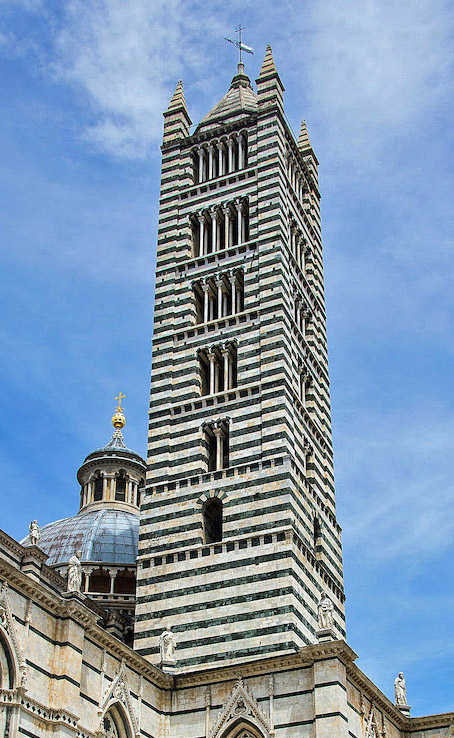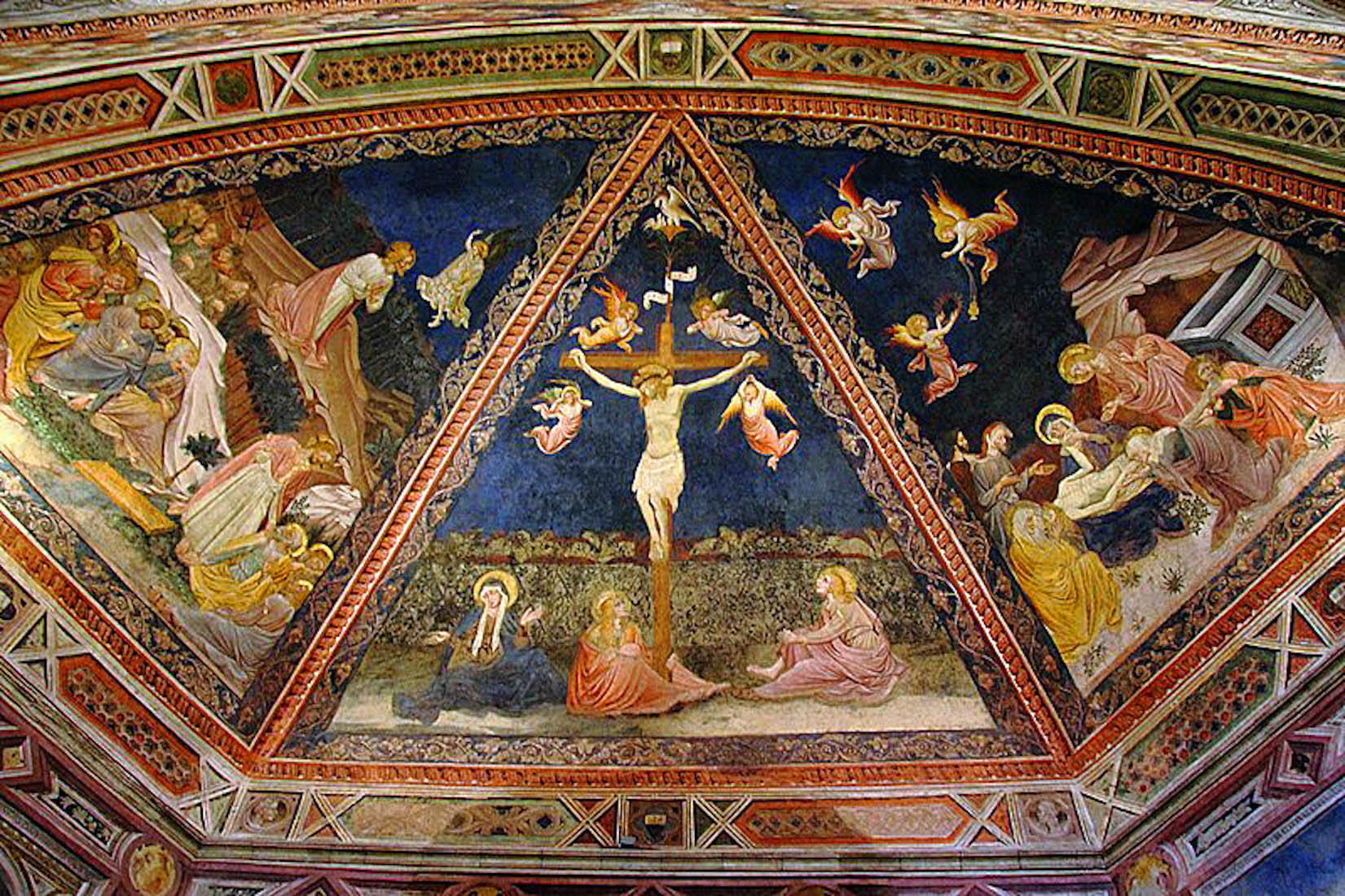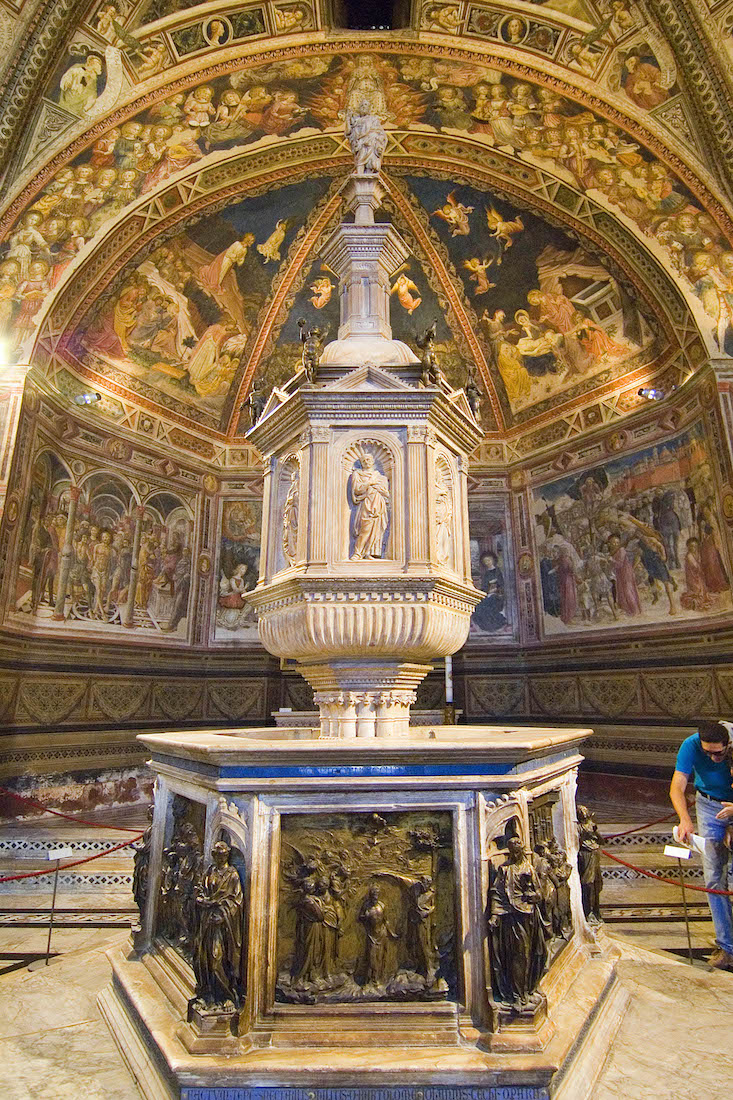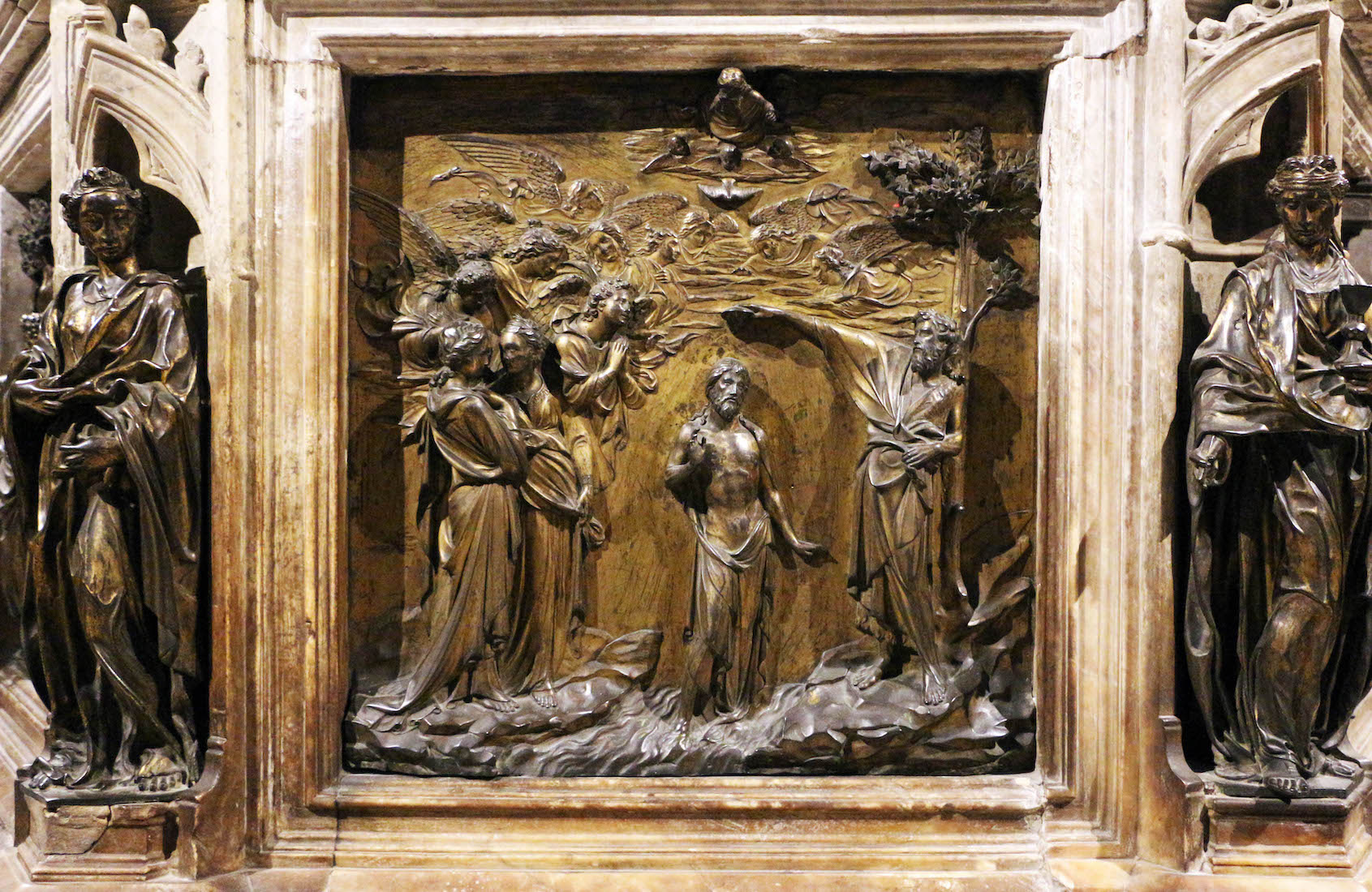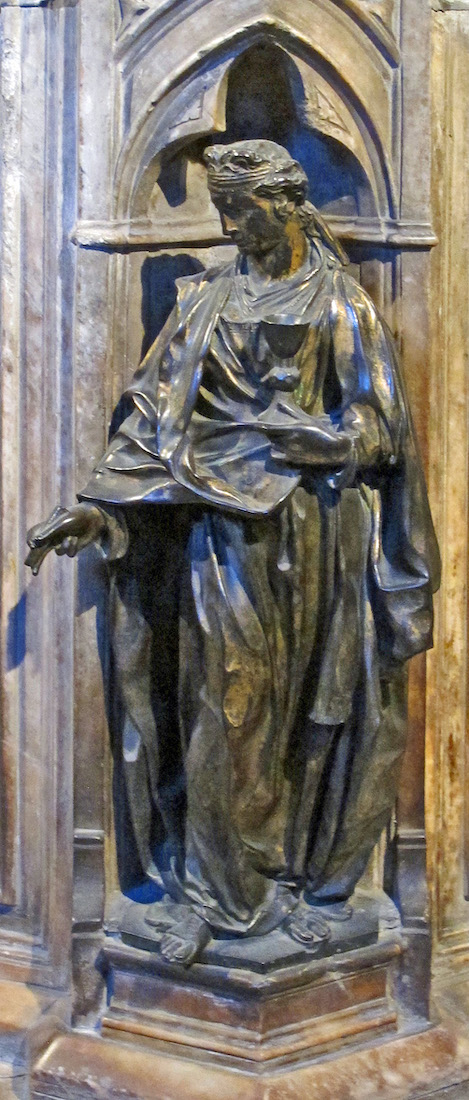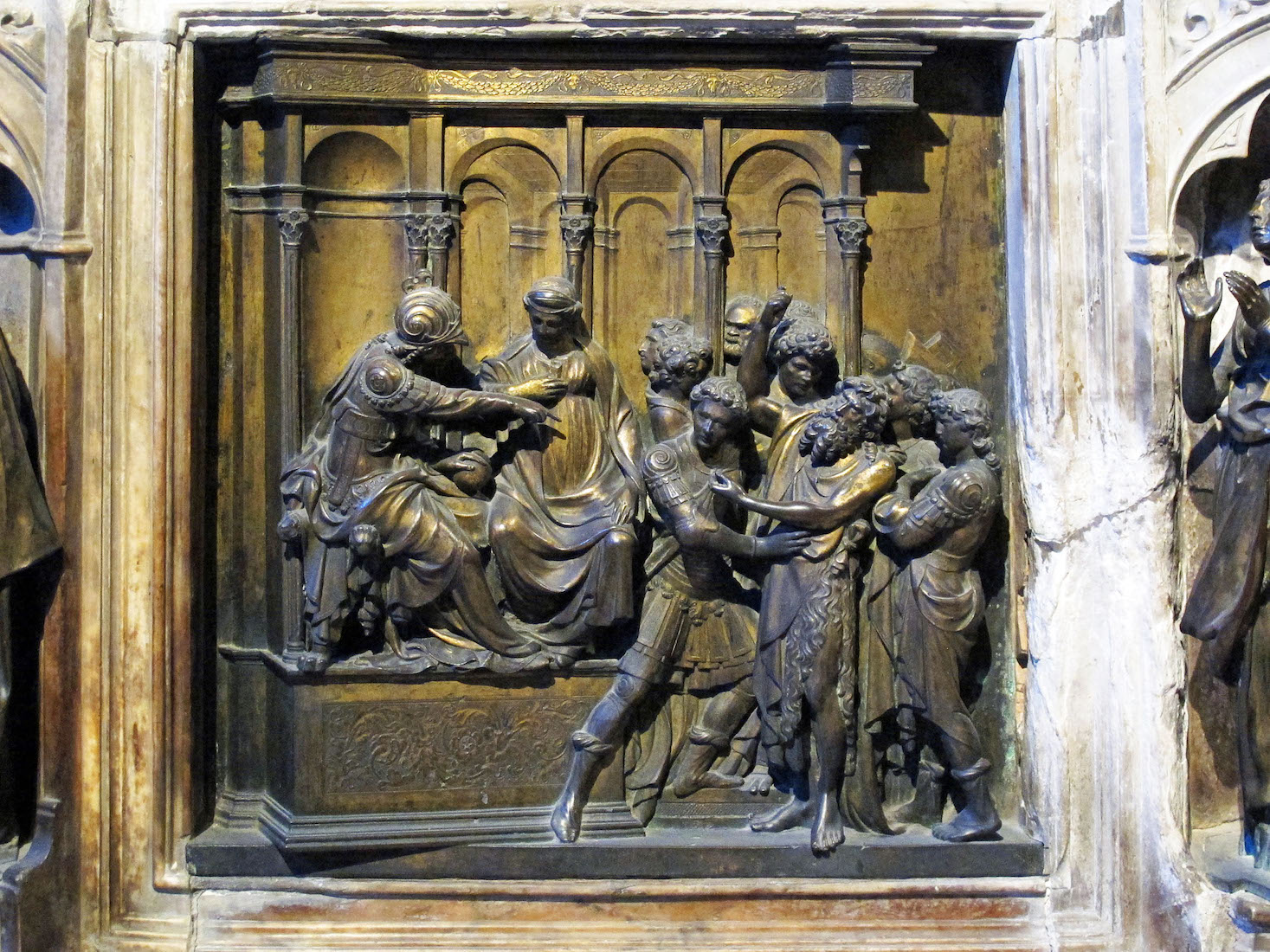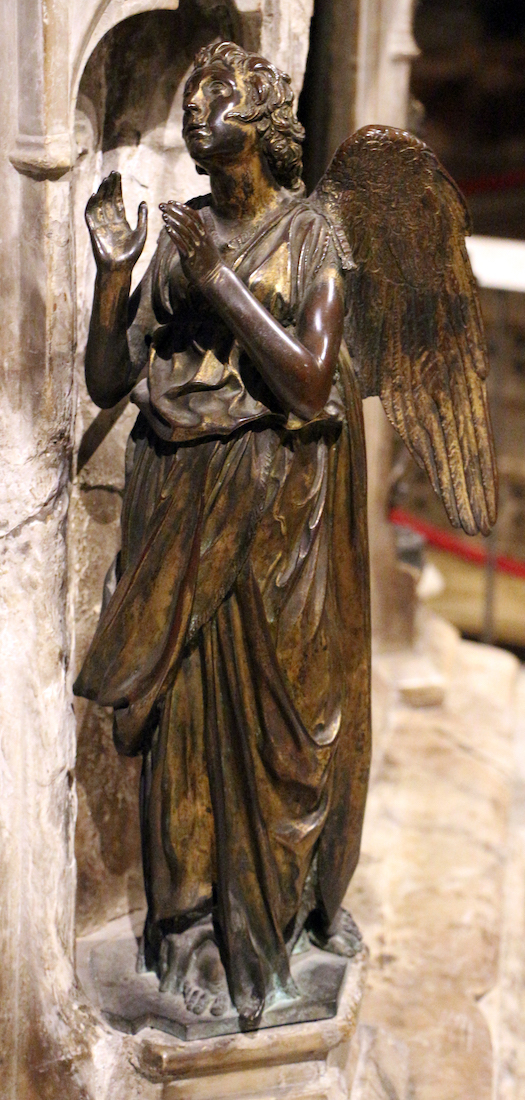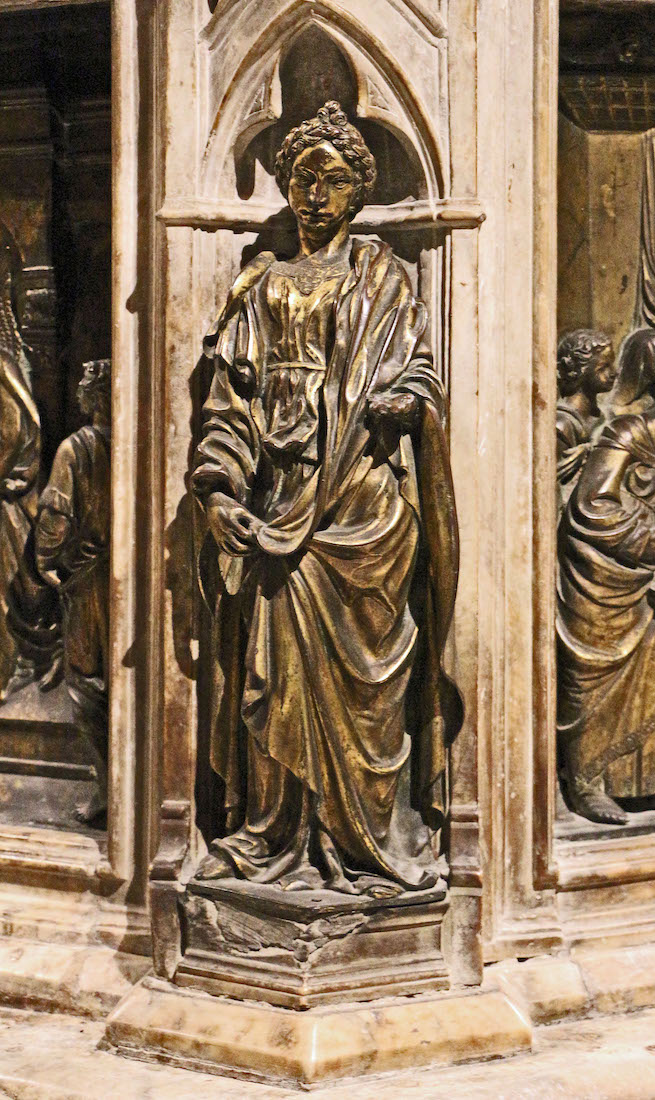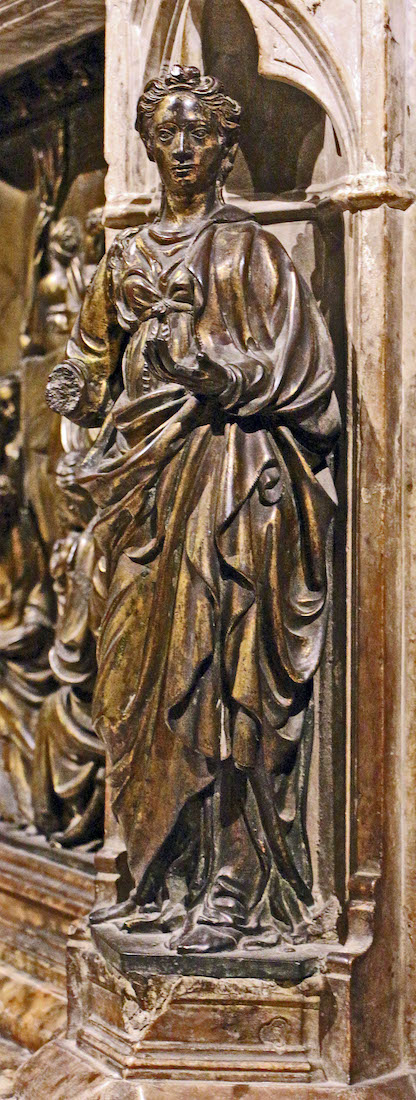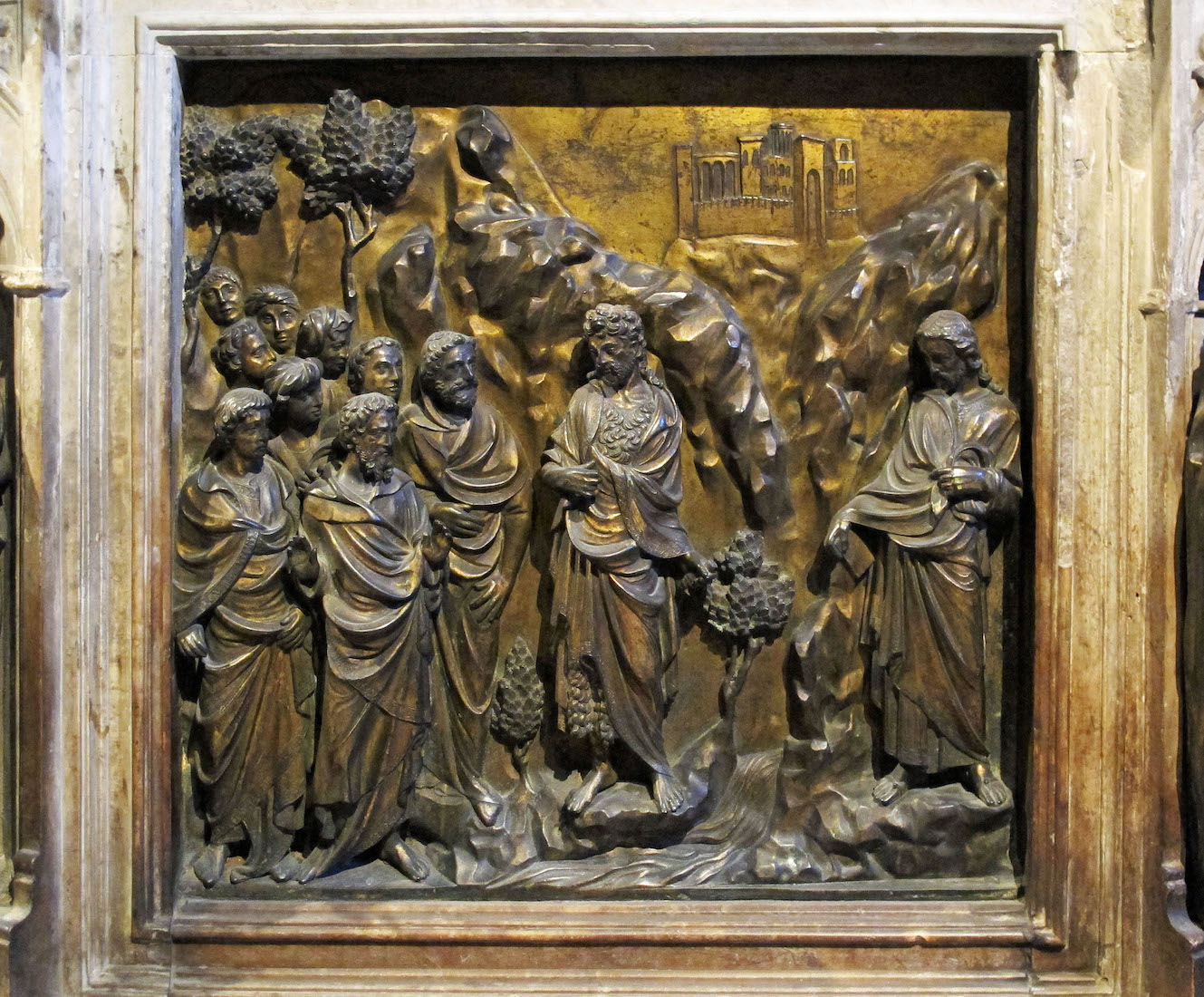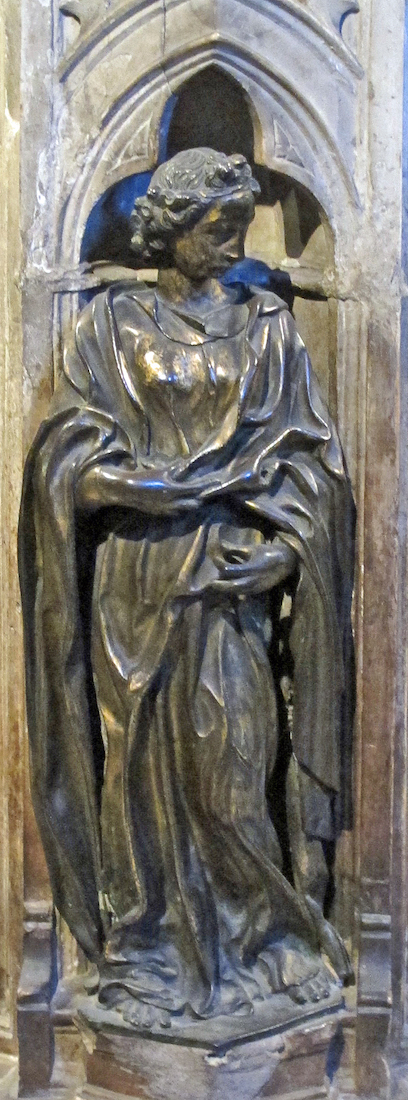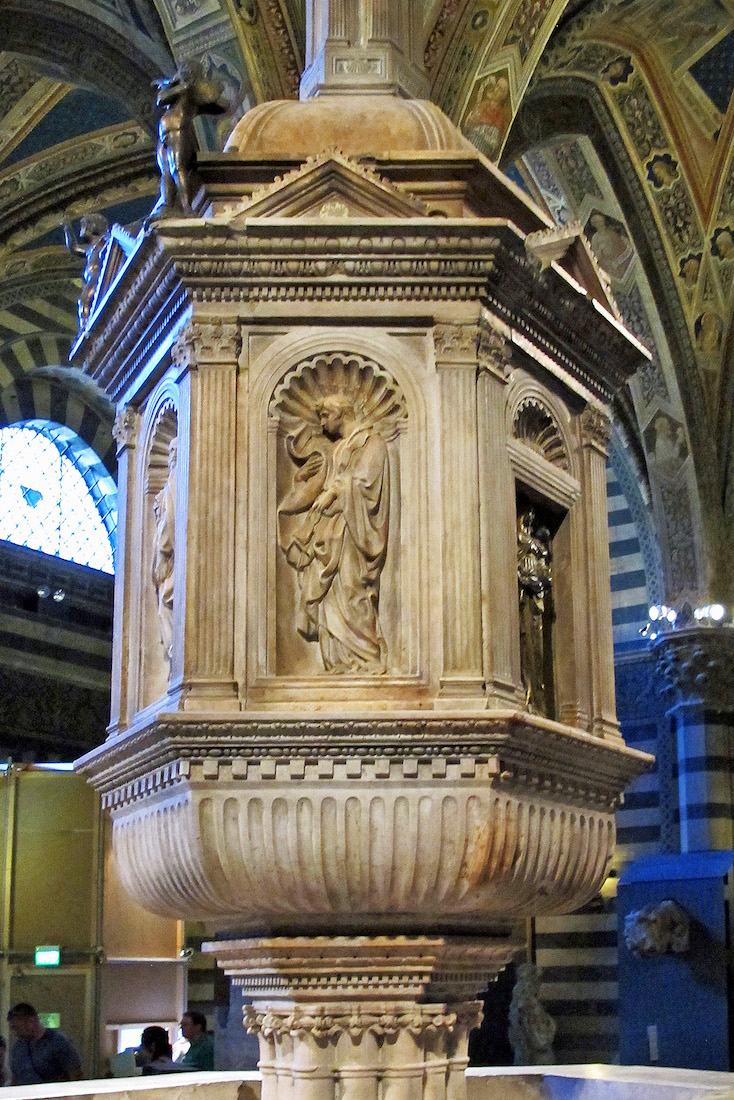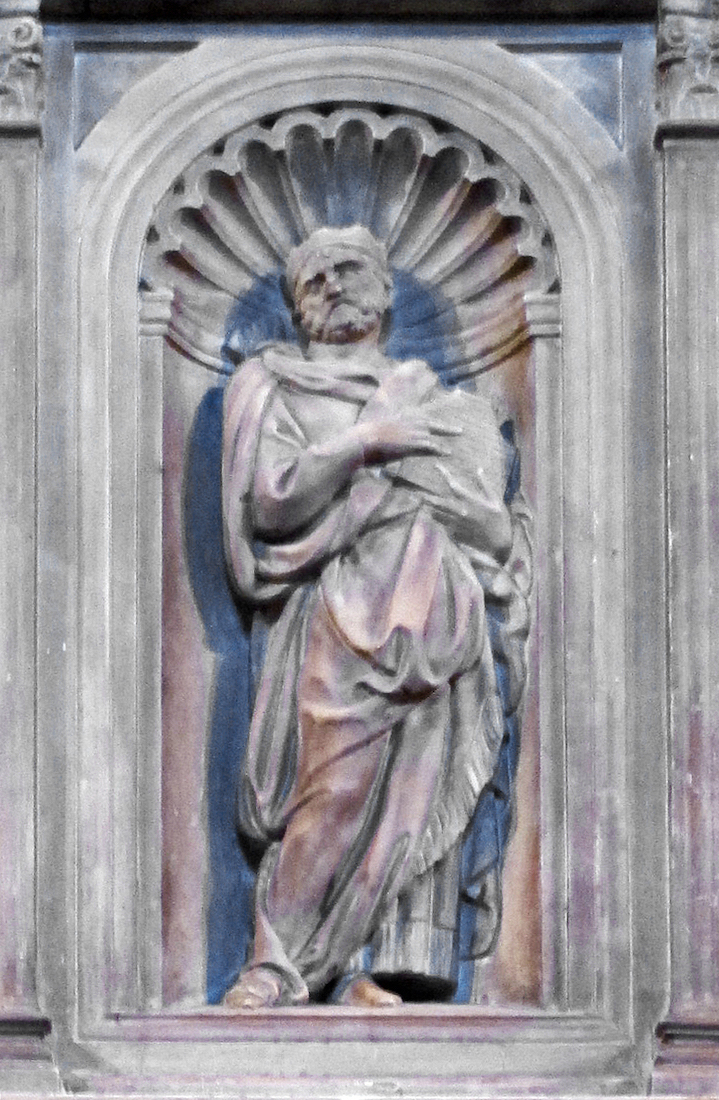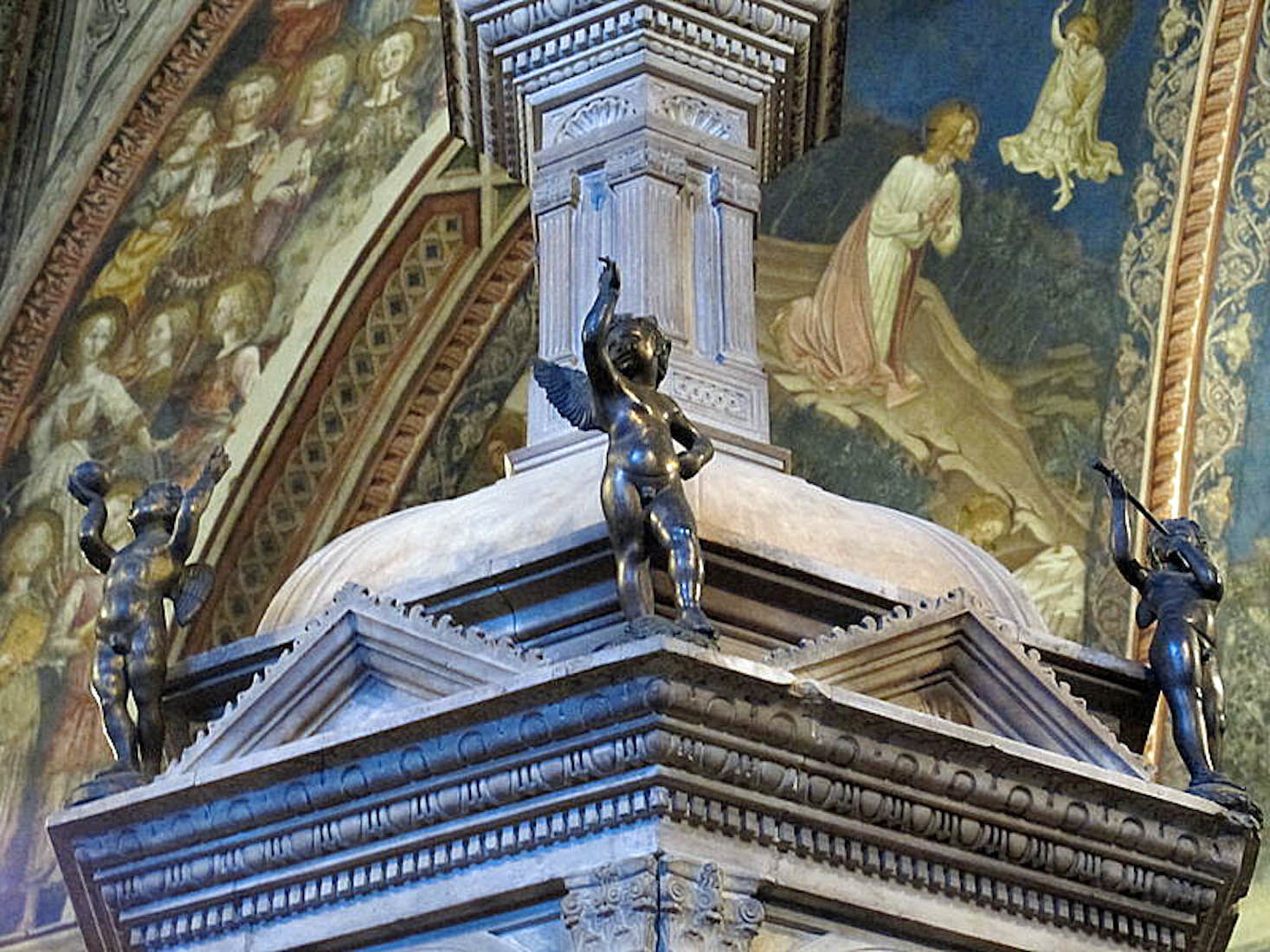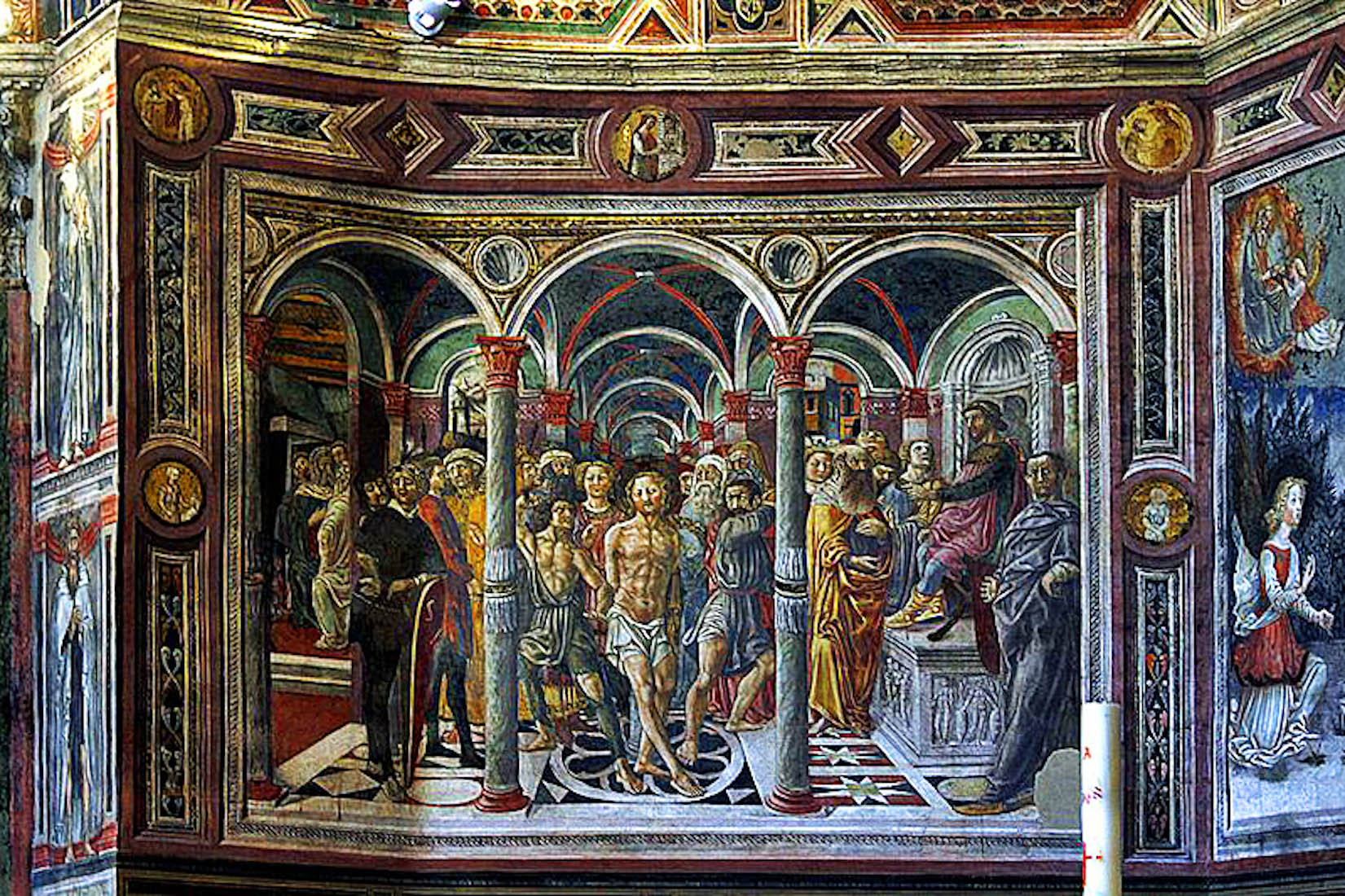
We begin by looking at the central apse. This apse has a central painting of the baptism of Jesus, and then there is a fresco on each side. The fresco to the left is The Flagellation, and is by Vecchietta (1447–1450).] INDEX
G22. CENTRAL APSE PAINTING FB
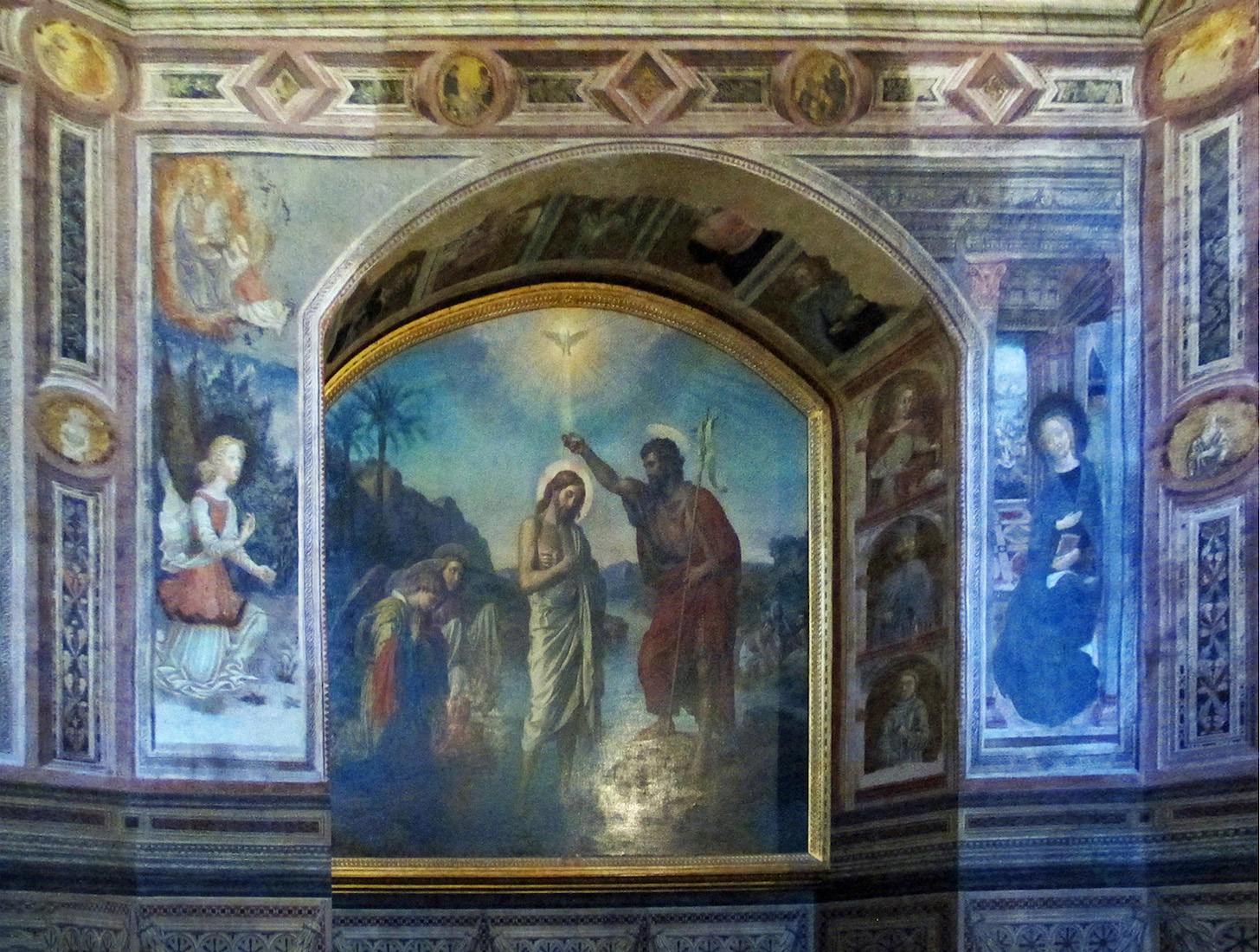
Dating from 1907 is a depiction of the Baptism of Jesus on the high altar, the work of Alessandro Franchi.
G23. THE ROAD TO CALVARY FB
This fresco on the right is also by Vecchietta, and is entitled The Road to Calvary.
G24. APSE VAULT FRESCOES WC
These frescoes in the vault of the apse were painted in 1477 by Michele di Matteo da Bologna. They show Jesus praying in the Garden of Gethsemane (Agony in the Garden), the Crucifixion, and the placing of the body of Jesus in the tomb (Deposition in the Tomb). [Photo Credit: Rabe!]
G25. BAPTISMAL FONT WC
In the centre of this space stands the hexagonal baptismal font in bronze, marble and vitreous enamel, realized in 1417-1431 by the main sculptors of the time: Donatello, Lorenzo Ghiberti, Giovanni di Turino, Goro di Neroccio and Jacopo della Quercia . This font is very interesting with scenes from the life of St John the Baptist in sequence around the bottom panels with various Virtues standing between, prophets above on the sides of a hexagonal tabernacle, some cheerful cherubs and John the Baptist himself standing at the top. We begin by looking at the panels and adjacent figures, beginning from the altar side. [Photo Credit: gaspa]
G26. FONT PANEL 1, CORNER FIGURE 1 FB FB
This first panel shows the Annunciation to Zacharias, by Jacopo dell Quercia (1428-29). The figure at right is Charity, by Giovanni di Turino (1431).
G27. FONT PANEL 2, CORNER FIGURE 2 FB FB
Next in an anticlockwise direction is the Birth of John the Baptist by Giovanni di Turino (1427). The figure to the right is Prudence (Providence?) by Giovanni di Turino (1431).
G28. FONT PANEL 3, CORNER FIGURE 3 FB FB
The next panel shows the Baptist Preaching, by Giovanni di Turino (1427). The figure to the right is Justice, by Giovanni di Turino (1431).
G29. FONT PANEL 4, CORNER FIGURE 4 FB FB
Next we see the Baptism of Christ by Ghiberti (1427). The figure at right is Faith, by Donatello (1429).
G30. FONT PANEL 5, CORNER FIGURE 5 FB FB
The fifth panel shows the Arrest of John the Baptist, by Ghiberti and Giuliano di Ser Andrea. The figure at right is Hope, by Donatello (1429).
G31. FONT PANEL 6, CORNER FIGURE 6 FB FB
And the final panel shows the Feast of Herod by Donatello (1427). The figure at right is Fortitude, by Goro di Ser Nereoccio (1431).
G32. TOP OF THE FONT WC
We now look at the upper part of the font. [Photo Credit: Rabe!]
G33. PLACING OF THE PROPHETS AND MADONNA FB
In the niches above the water receptacle are five prophets (apostles?), and a sculpted image of the Madonna and Child.
G34. DETAILS OF THE PROPHETS AND MADONNA FB FB
The prophets were designed by Jacopo della Quercia between 1427 and 1429. The Madonna and Child figure is part of a door which opens to reveal the baptismal oils. More detailed views of these figures can be seen here.
G35. CHEERFUL CHERUBS FB
Above the prophets are some joyful cherubs or ‘putti’. We can view them more closely here.
G36. ST JOHN THE BAPTIST JLBR
The figure of St John the Baptist at the top of the font was designed by Jacopo della Quercia.
CONCLUSION LM
I hope you have enjoyed visiting Siena Cathedral as much as I have. What a journey it has been! Interestingly, not every visitor has had a high opinion of the Cathedral. John Ruskin wrote:
‘I had a bad weary headache at Siena; and the cathedral seemed to me every way absurd – over-cut, over-striped, over-crocketed, over-gabled, a piece of costly confectionary, and faithless vanity.’
He did have a bad day!
The two main contributing photographers to this site are Francesco Bini, and ‘Le Monde1‘. As previously, I have been thrilled with the readiness of people to share their photos! Contributions are denoted by initials: FB and LM. The originals of ‘Le Monde1’ s photos can be found under the following link:
https://www.flickr.com/photos/31068574@N05/albums/72157667251591254
Francesco Bini’s photos all come under the CCL free-to-use category. They are to be found under Wikmedia Commons using the name ‘sailko’, and are listed under various topic categories. Although I am free to use Francesco’s photos, I found I was using so many that I wanted to give him credit on the Title Page. He readily agreed, and I appreciate his cooperation ... and many photos. Use of other CCL photos is accredited within the text. Special mentions: Elliot Brown [EB] who has a Flickr page:
https://www.flickr.com/photos/ell-r-brown/albums/72157696403696352
and José Luiz Bernades Ribeiro [JLBR] whose contributions appear under various Cathedral categories in Wikimedia Commons.
I take little credit for the text which comes from a variety of different sources.
I also express my thanks to my wife Margie who dutifully reads through all my websites and checks the typing.
I would be glad to receive any comments, criticisms or corrections to this site. The best websites are those which contain no errors!
A good explanatory site for Siena Cathedral has link
https://operaduomo.siena.it/en/sites/cathedral/
Paul Scott
